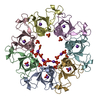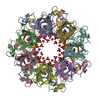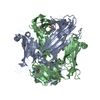+ Open data
Open data
- Basic information
Basic information
| Entry | Database: PDB / ID: 1g31 | |||||||||
|---|---|---|---|---|---|---|---|---|---|---|
| Title | GP31 CO-CHAPERONIN FROM BACTERIOPHAGE T4 | |||||||||
 Components Components | GP31 | |||||||||
 Keywords Keywords | CHAPERONE / CO-CHAPERONIN / GROES / IN VIVO PROTEIN FOLDING / BACTERIOPHAGE T4 | |||||||||
| Function / homology |  Function and homology information Function and homology information | |||||||||
| Biological species |  Enterobacteria phage T4 (virus) Enterobacteria phage T4 (virus) | |||||||||
| Method |  X-RAY DIFFRACTION / X-RAY DIFFRACTION /  SYNCHROTRON / SYNCHROTRON /  MOLECULAR REPLACEMENT / Resolution: 2.3 Å MOLECULAR REPLACEMENT / Resolution: 2.3 Å | |||||||||
 Authors Authors | Hunt, J.F. / Van Der Vies, S.M. / Henry, L. / Deisenhofer, J. | |||||||||
 Citation Citation |  Journal: Cell(Cambridge,Mass.) / Year: 1997 Journal: Cell(Cambridge,Mass.) / Year: 1997Title: Structural adaptations in the specialized bacteriophage T4 co-chaperonin Gp31 expand the size of the Anfinsen cage. Authors: Hunt, J.F. / van der Vies, S.M. / Henry, L. / Deisenhofer, J. #1:  Journal: Proc.Natl.Acad.Sci.USA / Year: 1996 Journal: Proc.Natl.Acad.Sci.USA / Year: 1996Title: Interplay of Structure and Disorder in Cochaperonin Mobile Loops Authors: Landry, S.J. / Taher, A. / Georgopoulos, C. / Van Der Vies, S.M. #2:  Journal: Nature / Year: 1994 Journal: Nature / Year: 1994Title: Bacteriophage T4 Encodes a Co-Chaperonin that Can Substitute for Escherichia Coli Groes in Protein Folding Authors: Van Der Vies, S.M. / Gatenby, A.A. / Georgopoulos, C. #3:  Journal: J.Mol.Biol. / Year: 1970 Journal: J.Mol.Biol. / Year: 1970Title: A Factor Preventing the Major Head Protein of Bacteriophage T4 from Random Aggregation Authors: Laemmli, U.K. / Beguin, F. / Gujer-Kellenberger, G. | |||||||||
| History |
|
- Structure visualization
Structure visualization
| Structure viewer | Molecule:  Molmil Molmil Jmol/JSmol Jmol/JSmol |
|---|
- Downloads & links
Downloads & links
- Download
Download
| PDBx/mmCIF format |  1g31.cif.gz 1g31.cif.gz | 173.6 KB | Display |  PDBx/mmCIF format PDBx/mmCIF format |
|---|---|---|---|---|
| PDB format |  pdb1g31.ent.gz pdb1g31.ent.gz | 136.9 KB | Display |  PDB format PDB format |
| PDBx/mmJSON format |  1g31.json.gz 1g31.json.gz | Tree view |  PDBx/mmJSON format PDBx/mmJSON format | |
| Others |  Other downloads Other downloads |
-Validation report
| Summary document |  1g31_validation.pdf.gz 1g31_validation.pdf.gz | 452.9 KB | Display |  wwPDB validaton report wwPDB validaton report |
|---|---|---|---|---|
| Full document |  1g31_full_validation.pdf.gz 1g31_full_validation.pdf.gz | 470.5 KB | Display | |
| Data in XML |  1g31_validation.xml.gz 1g31_validation.xml.gz | 17.6 KB | Display | |
| Data in CIF |  1g31_validation.cif.gz 1g31_validation.cif.gz | 29.8 KB | Display | |
| Arichive directory |  https://data.pdbj.org/pub/pdb/validation_reports/g3/1g31 https://data.pdbj.org/pub/pdb/validation_reports/g3/1g31 ftp://data.pdbj.org/pub/pdb/validation_reports/g3/1g31 ftp://data.pdbj.org/pub/pdb/validation_reports/g3/1g31 | HTTPS FTP |
-Related structure data
| Similar structure data |
|---|
- Links
Links
- Assembly
Assembly
| Deposited unit | 
| |||||||||||||||||||||||||||||||||||||||||||||||||||||||||||||
|---|---|---|---|---|---|---|---|---|---|---|---|---|---|---|---|---|---|---|---|---|---|---|---|---|---|---|---|---|---|---|---|---|---|---|---|---|---|---|---|---|---|---|---|---|---|---|---|---|---|---|---|---|---|---|---|---|---|---|---|---|---|---|
| 1 |
| |||||||||||||||||||||||||||||||||||||||||||||||||||||||||||||
| 2 | 
| |||||||||||||||||||||||||||||||||||||||||||||||||||||||||||||
| Unit cell |
| |||||||||||||||||||||||||||||||||||||||||||||||||||||||||||||
| Components on special symmetry positions |
| |||||||||||||||||||||||||||||||||||||||||||||||||||||||||||||
| Noncrystallographic symmetry (NCS) | NCS domain:
NCS oper:
|
- Components
Components
| #1: Protein | Mass: 12091.999 Da / Num. of mol.: 7 Source method: isolated from a genetically manipulated source Source: (gene. exp.)  Enterobacteria phage T4 (virus) / Genus: T4-like viruses / Species: Enterobacteria phage T4 sensu lato / Cellular location: CYTOPLASM / Gene: 31 / Organ: BRAIN / Plasmid: PSV25 / Cellular location (production host): CYTOPLASM / Gene (production host): GROES / Production host: Enterobacteria phage T4 (virus) / Genus: T4-like viruses / Species: Enterobacteria phage T4 sensu lato / Cellular location: CYTOPLASM / Gene: 31 / Organ: BRAIN / Plasmid: PSV25 / Cellular location (production host): CYTOPLASM / Gene (production host): GROES / Production host:  #2: Chemical | ChemComp-PO4 / #3: Chemical | ChemComp-K / #4: Water | ChemComp-HOH / | Nonpolymer details | THE PHOSPHATE AND POTASSIUM IONS WITH RESIDUE NUMBERS FROM 1151 - 1184 LIE IN 4 CO-PLANAR AND ...THE PHOSPHATE AND POTASSIUM IONS WITH RESIDUE NUMBERS FROM 1151 - 1184 LIE IN 4 CO-PLANAR AND CONCENTRIC | |
|---|
-Experimental details
-Experiment
| Experiment | Method:  X-RAY DIFFRACTION / Number of used crystals: 1 X-RAY DIFFRACTION / Number of used crystals: 1 |
|---|
- Sample preparation
Sample preparation
| Crystal | Density Matthews: 3.34 Å3/Da / Density % sol: 65 % Description: THE SEARCH MODEL CONTAINED ONLY 68% OF THE RESIDUES THAT EVENTUALLY APPEARED IN THE STRUCTURE AND THERE IS ONLY 17% SEQUENCE IDENTITY IN THIS REGION. | ||||||||||||||||||||||||||||||||||||||||||||||||||||||
|---|---|---|---|---|---|---|---|---|---|---|---|---|---|---|---|---|---|---|---|---|---|---|---|---|---|---|---|---|---|---|---|---|---|---|---|---|---|---|---|---|---|---|---|---|---|---|---|---|---|---|---|---|---|---|---|
| Crystal grow | Details: PROTEIN WAS CRYSTALLIZED AT 17 MG/ML FROM 0.42 M NAH(2)PO(4), 1.70 M K(2)HPO(4), 10 MM BES, 6 MM DTT, 0.035% NAN(3), 29% ETHYLENE GLYCOL. | ||||||||||||||||||||||||||||||||||||||||||||||||||||||
| Crystal | *PLUS | ||||||||||||||||||||||||||||||||||||||||||||||||||||||
| Crystal grow | *PLUS Temperature: 21 ℃ / pH: 7 / Method: vapor diffusion, sitting drop | ||||||||||||||||||||||||||||||||||||||||||||||||||||||
| Components of the solutions | *PLUS
|
-Data collection
| Diffraction | Mean temperature: 100 K |
|---|---|
| Diffraction source | Source:  SYNCHROTRON / Site: SYNCHROTRON / Site:  CHESS CHESS  / Beamline: F1 / Wavelength: 0.918 / Beamline: F1 / Wavelength: 0.918 |
| Detector | Type: PRINCETON 2K / Detector: CCD / Date: Jan 1, 1997 / Details: BENT FOCUSING MIRRORS |
| Radiation | Monochromator: SI(111) / Monochromatic (M) / Laue (L): M / Scattering type: x-ray |
| Radiation wavelength | Wavelength: 0.918 Å / Relative weight: 1 |
| Reflection | Resolution: 2.3→20 Å / Num. obs: 42831 / % possible obs: 83.5 % / Observed criterion σ(I): 1 / Redundancy: 5.95 % / Biso Wilson estimate: 25.2 Å2 / Rsym value: 0.108 / Net I/σ(I): 10.6 |
| Reflection shell | Resolution: 2.3→2.4 Å / Mean I/σ(I) obs: 1.9 / Rsym value: 0.39 / % possible all: 65 |
| Reflection | *PLUS Rmerge(I) obs: 0.108 |
- Processing
Processing
| Software |
| ||||||||||||||||||||||||||||||||||||||||||||||||||||||||||||||||||||||||||||||||
|---|---|---|---|---|---|---|---|---|---|---|---|---|---|---|---|---|---|---|---|---|---|---|---|---|---|---|---|---|---|---|---|---|---|---|---|---|---|---|---|---|---|---|---|---|---|---|---|---|---|---|---|---|---|---|---|---|---|---|---|---|---|---|---|---|---|---|---|---|---|---|---|---|---|---|---|---|---|---|---|---|---|
| Refinement | Method to determine structure:  MOLECULAR REPLACEMENT MOLECULAR REPLACEMENTStarting model: ESCHERICHIA COLI GROES 2.8 ANGSTROM MODEL Resolution: 2.3→20 Å / Rfactor Rfree error: 0.004 / Data cutoff high absF: 1000000 / Data cutoff low absF: 0.01 / Isotropic thermal model: RESTRAINED / Cross valid method: THROUGHOUT / σ(F): 1 Details: THE CONFORMATION OF RESIDUES 25 - 31 IS VERY APPROXIMATELY DEFINED IN ALL 7 CHAINS BECAUSE OF THE DIFFUSE NATURE OF THE ELECTRON DENSITY IN THIS REGION. THE MOLECULAR IDENTITY OF 10.5 OF THE ...Details: THE CONFORMATION OF RESIDUES 25 - 31 IS VERY APPROXIMATELY DEFINED IN ALL 7 CHAINS BECAUSE OF THE DIFFUSE NATURE OF THE ELECTRON DENSITY IN THIS REGION. THE MOLECULAR IDENTITY OF 10.5 OF THE 17.5 PHOSPHATE IONS IN THE ASYMMETRIC UNIT WAS UNAMBIGUOUS BASED ON THEIR ELECTRON DENSITY IN AVERAGED MAPS AS WELL AS STEREOCHEMICAL AND REFINEMENT CRITERIA; THE MOLECULAR IDENTIFICATION OF THE OTHER SOLVENT IONS / MOLECULES REPRESENTS MORE TENTATIVE JUDGEMENTS BASED ON THE SAME CRITERIA.
| ||||||||||||||||||||||||||||||||||||||||||||||||||||||||||||||||||||||||||||||||
| Displacement parameters | Biso mean: 61.6 Å2
| ||||||||||||||||||||||||||||||||||||||||||||||||||||||||||||||||||||||||||||||||
| Refine analyze |
| ||||||||||||||||||||||||||||||||||||||||||||||||||||||||||||||||||||||||||||||||
| Refinement step | Cycle: LAST / Resolution: 2.3→20 Å
| ||||||||||||||||||||||||||||||||||||||||||||||||||||||||||||||||||||||||||||||||
| Refine LS restraints |
| ||||||||||||||||||||||||||||||||||||||||||||||||||||||||||||||||||||||||||||||||
| Refine LS restraints NCS |
| ||||||||||||||||||||||||||||||||||||||||||||||||||||||||||||||||||||||||||||||||
| LS refinement shell | Resolution: 2.3→2.4 Å / Rfactor Rfree error: 0.023 / Total num. of bins used: 8
| ||||||||||||||||||||||||||||||||||||||||||||||||||||||||||||||||||||||||||||||||
| Xplor file |
| ||||||||||||||||||||||||||||||||||||||||||||||||||||||||||||||||||||||||||||||||
| Software | *PLUS Name:  X-PLOR / Version: 3.1 / Classification: refinement X-PLOR / Version: 3.1 / Classification: refinement | ||||||||||||||||||||||||||||||||||||||||||||||||||||||||||||||||||||||||||||||||
| Refine LS restraints | *PLUS
|
 Movie
Movie Controller
Controller









 PDBj
PDBj






